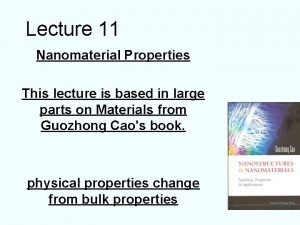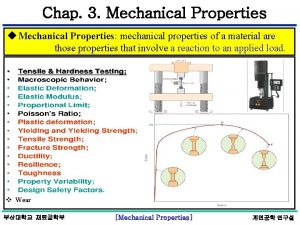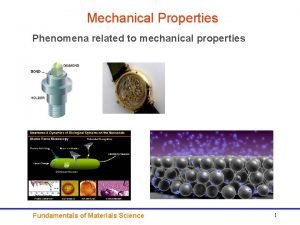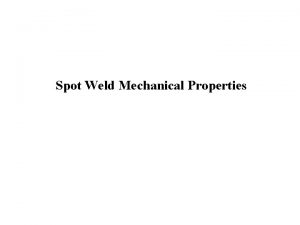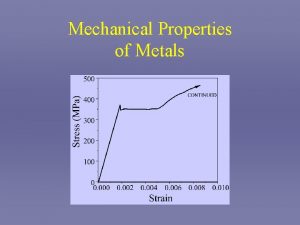CHAPTER 6 MECHANICAL PROPERTIES Mechanical properties Why are










- Slides: 10

CHAPTER 6: MECHANICAL PROPERTIES Mechanical properties: Why are mechanical properties important in Materials Science and Engineering? 1. It is often neccessary to design materials with high mechanical strength. 2. It is often neccessary to correlate the mechanical properties with the performance of the product in real life. 3. Mechanical properties have a close relationship with the structure and morphology of a material.

CHAPTER 6: MECHANICAL PROPERTIES Stress: It is the ratio of a load (usually in N) applied to the surface area of a material to the cross-sectional area. = Force/Area The unit of the stress is Pascal (1 N/m 2). Strain: It is the ratio of the change in the length of a material to its initial length. Tension Tests: An increasing load, F is applied uniaxially along the long axis of a specimen.


Figure 6. 1

Compression Tests: This test is the opposite of tension test. During the compression test, the specimen contracts along the direction of the stress. The force that is applied to the specimen is compressive. Figure 6. 1 Engineering Stress: It is the force or load that is applied to the specimen divided by the initial cross-sectional area. = Force / Initial Area = F/Ao Engineering Strain: It is the change of the length of a specimen (the final length-the initial length) that is divided by the initial length. = (l-lo)/lo

Shear Tests: A force, F is applied parallel to the upper and lower faces of a specimen, and the specimen is deformed along the direction of the applied force. Figure 6. 2 Torsional Tests: During the torsion test, torsional forces produce a rotational motion about the long axis of the specimen. Figure 6. 3

Shear stress

Torsional stress


ELASTIC DEFORMATION: In elastic deformation, the stress and strain are linearly proportional to each other. In other words, the plot of stress versus strain is a linear line. The slope of this line is E (Young’s modulus). Figure 6. 4: Stress-strain plot for an elastic deformation STRESS –STRAIN BEHAVIOR: For most metals, at low stress and strain values, the stress and strain are proportional to each other. = E This relation is called Hooke’s Law. E is called the Modulus of elasticity or Young’s modulus. The unit of E is psi (pounds per square inch) or MPa (Megapascal=106 Pascal).
 Antigentest åre
Antigentest åre Hey bye bye
Hey bye bye Dont ask
Dont ask Actual mechanical advantage vs ideal mechanical advantage
Actual mechanical advantage vs ideal mechanical advantage Lateral strain
Lateral strain Elastic modulus dental materials
Elastic modulus dental materials Mechanical properties of nano materials
Mechanical properties of nano materials Properties of mechanical waves
Properties of mechanical waves What are the properties of cardboard
What are the properties of cardboard Properties of mechanical waves
Properties of mechanical waves Properties of mechanical waves
Properties of mechanical waves






